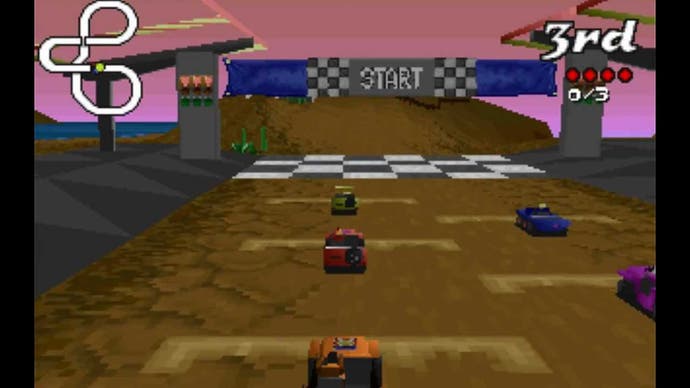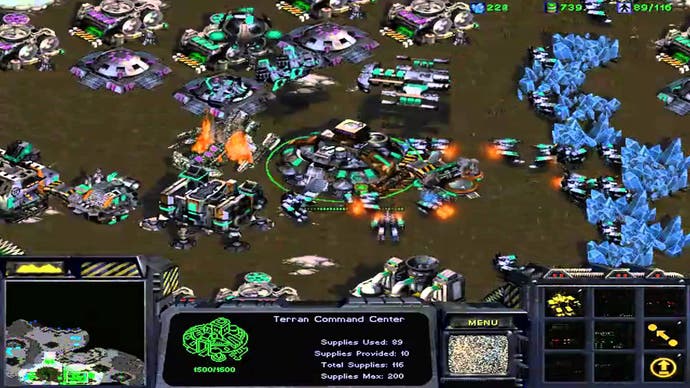The Ant Man: my year in development hell
A trip down myrmery lane.
There is a phrase in the media, you've probably heard it: 'development hell'. It refers to a film, television programme or, yes, video game, that has languished for many months, perhaps even years, in a state of tragic semi-production, often cast from one studio to another, perhaps re-written a few times, perhaps abandoned, only to be picked up later. Well, I have been to development hell - it is actually where I began and ended my career in game design, and where I learned one incredibly valuable lesson about why people play games. This is the story of Swarm Troopers.
In the summer of 1994, after leaving Warwick university with a degree in English and Theatre Studies, I went to work full time at Big Red Software, a small development studio based in Leamington Spa. I've written a few times about my adventures there - that time I spent a whole summer testing Game Genie codes for example - but this is the part I haven't told you. Because it is a painful story of failure.
The mid-nineties was a tough time in the UK video game industry. A lot of the major publishers and developers had grown up working on home computers like the Commodore 64, Spectrum and Amiga; the teams were small, the projects often eccentric. But then came the Sony PlayStation with its amazing graphics processor and its promise of complex 3D visuals. Suddenly game studios had to grow in size and ambition; they had to start thinking about big budget games, with state-of-the-art visuals for global audiences. Some British companies adapted well - Gremlin did brilliantly for a few years with its Actua Soccer titles, and Psygnosis was bought by Sony and made landmark titles like Wipeout and G-Police. But other veterans struggled. There were a lot of closures, a lot of takeovers, a lot of ambitious projects floundering between the 16bit era and the dawn of the modern console age.
We were right in the middle of it. At the time, Big Red was working on its comedy driving game Big Red Racing. I had completed my work on that title - and by 'work' I mean writing the instruction manual, in-game text and a very elaborate backstory that was later canned. The boss of Big Red, Paul Ranson, didn't know what to do with me next, but he was a lovely guy, so was determined to keep me on. Then we got lucky. Lucky-ish. And it had to do with our publisher at the time: Domark, a veteran of the UK scene, best known for backing Championship Manager when almost no one else would. They had ambitions.

"Domark were still in an office in Putney I think, and their internal development team The Kremlin was in the basement," recalls my friend Jon Cartwright, who also worked at Big Red during this era. "I have memories of them still working on Deathtrap Dungeon on PC down there. At that point Big Red were really quite in favour at Domark, it may even have been round the time that the Eidos takeover of Domark, Simis and Big Red was in the due diligence stage. I have some memory of a pub lunch at The Blue Lias outside Southam, where we were based at the time, with Charles Cornwall, the CEO of Eidos when they were a video compression company. He asked us if we wanted to work on PlayStation. We did."
At the time, we didn't have a project that was suitable, but this is where development hell comes in. There was something floating around at Domark HQ, a kind of 3D game involving insects and racing. For some reason that history or sense has disbarred me from remembering, we were given that to mess about with. Paul, sensing a chance to make me feel useful, asked me to come up with some ideas - but he wanted to ditch the racing element because we were already making a racing game. So I had insects to work with.
We were all really into turn-based strategy games like XCOM and Civilisation at the time, so somehow we came up with the idea of warring insect factions, fighting to control a hostile landscape. I think we'd also played Sim Ant quite a bit, so that was chucked into the mix too. This all percolated, as these things do in small studios, until we had the idea for a turn-based ant strategy game, where intelligent hives battled each other for domination. I started working on a basic concept, researching ant species and behaviours. I discovered a lot about ant nest hierarchies and realised that a lot of how they functioned matched the way military forces operate. I also realised we could create basic unit types out of soldier and worker ants, as well as various species, like horse ants that can spray formic acid and fire ants that carry out rapid invasions of nearby colonies. I was starting to build a really in-depth understanding of ant strategy, and it all seemed to make sense within the structure of a turn-based military game. We even had a name. Swarm Troopers. You know, because insects swarm. And it sounds a bit like Storm Troopers, so that was cool.
I began to write a very detailed design document, positing that these ants were somehow mutated and therefore highly intelligent and perhaps even cybernetically augmented somehow. I'd been wondering about having an ending like the close of Planet of the Apes, where the camera pans out to reveal some wrecked landmark and you realise these are actually giant ants fighting each other on a devastated Earth. I really thought this crap through.

Then the first setback. Command & Conquer came out. Suddenly it was all about real-time strategy. Turn-based was dead. It was a bit like when the Sex Pistols arrived and killed prog rock, except with more ranged missile combat. We had a panic meeting in the pub. Swarm Troopers would have to go real-time. This was fine for me because I was still building the unit types and back story - I didn't have to worry too much. But programmer Fred Williams was already building a rudimentary 3D environment and coding an engine. I was vaguely aware there would be some balance issues too, but I was young and naive and was more concerned with the fact that most of the ants in our office ant farm appeared to be dying. Yes, we bought an ant farm for research. It was a really hot summer and they arrived through the post and I don't think they ever recovered from that indignity. They managed to make one tunnel and then started to expire. This should have been read as a sign.
A few months later I had a bulky design document and a few concept sketches. Then Paul told me we'd have to go to Putney and pitch the concept to Domark. But not just anyone at Domark - we'd be pitching to the company's MD - Ian Livingstone. Ian Livingstone the industry legend who brought D&D to the UK and wrote those Fighting Fantasy books with Steve Jackson. That guy. That's who I'd be pitching my game to. The king of games.
We got the train down to London, Paul and me. He had stuff to do at Domark, so he introduced me to Ian and I was on my own. Ian was and still is, an enthusiastic but also slightly laconic figure - I was in awe - even when he asked if he could borrow a pound to use in the coke machine in the hallway. A coke machine that he technically owned. I lent him the pound anyway. Then we sat in his office - him behind the desk surrounded by games and books that he'd made or published, and I sat with my design document for Swarm Troopers - a game that I'd helped design without any formal training or experience. And now here I was pitching it.
I was terrified. I mean, all the way through the process I'd been sort of confused and disarmed - I was a drama student so I wasn't used to being taken seriously by functioning adults. What was I doing here in this office in Putney, pitching a PlayStation game at the man who would, in a few years time, fund Tomb Raider?

I pitched the game. I explained the dynamics - the way different ant tribes would have different tactics and weapons based on realistic ant behaviours, I pitched the backstory of nuclear Armageddon, I pitched the idea that it would be a real-time strategy game in a 3D environment so it was totally suitable for the glamorous sexy age of PlayStation. I pitched and he listened. And listened some more. And then he thought.
He thought and I sat there, wondering if he would have questions about the effective damage range of formic acid. But he didn't. Instead he got up to show me out, and I gathered my papers and followed him. And then he said to me, in a vaguely parental, conciliatory tone, "The problem is, no one wants to be an ant."
I gulped. I actually think I audibly gulped. A big Scooby-Doo cartoon gulp. Because, of-fecking-course. Of course. Of course, no one would want to play a game in which they were teeny ants fighting over a garden - even if it was a post-apocalyptic garden. Video games are about aspiration and embodiment. If you look at StarCraft, C&C or Total Annihilation, those are cool armies of space marines and aliens and soldiers. They're not ants. If you're going to be spending 30 hours building up an army, you don't want to build an army that could effectively be annihilated by a kettle full of hot water. It's not aspirational. At that time, people were playing Tekken and Ridge Racer and WipeOut and games were cool. Ants aren't cool. Or they weren't then. There was no cool Ant Man movie back then.
So yes, while spending weeks and weeks working on this game, getting the intricate unit design and military systems working, I'd overlooked something hugely fundamental - you have to think about *why* someone would want to play your game; what will players think about when they're playing - how will they imagine themselves into the role? Of course, not all games work like that - no one imagines themselves into the role of the long straight block in Tetris. But when you have sentient beings on screen for many hours, you'd better make them aspirational in some way. Ian Livingstone knew this. And he knew because he wrote The Warlock of Firetop Mountain.
I left dejected. Back at Big Red Software, everyone shrugged and went back to work. A few months later, I got offered a job at Edge Magazine and decided to be a journalist. The weird thing is, the studio didn't give up. In my absence, they re-designed the game, replaced the ants with actual soldiers and reconfigured the game as a really interesting third-person tactical shooter. It was called Raw War for a time, then it became Hard Corps. Eidos bought Big Red then didn't know what to do with the studio. My old colleagues worked on that game for a year. Then they were shut down.
That's the way the industry works. Development hell just happens. Sometimes it's because the game isn't very good; sometimes it's because things take place in the industry that no one saw coming.
Now, whenever I hear about a game getting canned, I think a lot about the people on the team - how it must feel to have the rug pulled from under their feet - especially if they'd spent the previous two years of their lives weaving the rug in the first place. In my career as a games journalist, I've reported on a lot of canned games and closed studios, it's always sad. And it takes me back to that year between 1994 and 1995 when I was a game designer, and I worked with my friends, and we had dumb ideas that almost came to fruition.
I kept the Swarm Troopers design documents for a while, but they're gone now.
Also, Ian Livingstone still owes me a pound.

